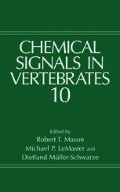Access this chapter
Tax calculation will be finalised at checkout
Purchases are for personal use only
Preview
Unable to display preview. Download preview PDF.
References
Blaustein, A. R., Bekoff, M., and Daniels, T. J., 1987, Kin recognition in vertebrates, in: Kin Recognition in Animals, D. J. C. Fletcher and C. D. Michener, eds, John Wiley and Sons, New York, pp. 287–257.
Doty, R. L., 1972, Odor preferences of female Peromyscus maniculatus bairdi for male use odors of P. M. bairdi and P. leucopus noveboracensis as a function of estrous state, J. Comp. Physiol. Psychol. 81:191–197.
Godfrey, J., 1958, The origin of sexual isolation between bank voles, Proc. R. Physiol. Soc. (Edinburgh) 27:47–55.
Hall, E. R., 1981, The Mammals of North America, Vol. II, 2nd edition, John Wiley and Sons, New York.
Halley, D., and Rosell, F., 2002, The beaver’s reconquest of Eurasia: status, population development and management of a conservation success, Mammal Review 32:153–178.
Kotenkova, E. V., and Naidenko, S. V., 1999, Discrimination of con-and heterospecific odors in different taxa of the Mus musculus species group, in: Chemical Signals in Vertebrates, R. E. Johnston, D. Miiller-Schwarze, and P. W. Sorensen, eds., Kluwer Academic / Plenum Publishers, New York, pp. 299–308.
Lavrov, L. S., and Orlov, V. N., 1973, Karyotypes and taxonomy of modem beavers (Castor, Castoridae, Mammalia), Zoologicheskii Zhurnal 52:734–742.
McKenzie, J. D. Jr., and Goldman, R., 1999, The Student Edition of Minitab for Windows 95 and Windows NT (manual and software). Addison-Wesley, New Jersey.
Mayr. E., 1970, Populations, Species and Evolution. Belknap Press of Harvard University, Cambridge, Massachusetts.
Moore, R. E., 1965, Olfactory discrimination as an isolation mechanism between Peromyscus maniculatus and Peromyscus polionotus, Am. Midl. Nat. 73:85–100.
Müller-Schwarze, D., 1974, Olfactory recognition of species, groups, individuals and physiological states among mammals, in: Pheromones, M. C. Birch, ed., North-Holland Publishing Company, Amsterdam, pp. 316–326.
Müller-Schwarze, D., 1992, Castoreum of beaver (Castor canadensis): function, chemistry and biological activity of its components, in: Chemical Signals in Vertebrates VI, R. L. Doty and D. Mü ller-Schwarze, eds., Plenum Press, New York, pp. 457–464.
Nolet, B. A., and Rosell, F., 1998, Comeback of the beaver Castor fiber: an overview of old and new conservation problems, Biol. Conserve. 83:165–173.
Osborn, D. J., 1955, Techniques of sexing beaver, Castor canadensis, J. Mammal. 36: 141–142.
Rauschert, K., 1963, Sexuelle Affinität zwischen Arten und Unterarten von Rötelmätusen (Clethrionomys), Biol. Zentralbl. 82:653–664.
Rosell, F. 2002, The function of scent marking in beaver (Castor fiber) territorial defence, PhD thesis, Norwegian University of Science and Technology, Trondheim, Norway.
Rosell, F., and Bjørkøyli, T., 2002, A test of the dear enemy phenomenon in the Eurasian beaver (Castor fiber), Anim. Behav. 6:1073–1078.
Rosell, F., and Nolet, B. A., 1997, Factors affecting scent-marking behavior in Eurasian beaver (Castor fiber), J. Chem. Ecol. 23:679–690.
Rosell, F., and Sun, L., 1999, Use of anal gland secretion to distinguish the two beaver species Castor canadensis and C. fiber, Wild. Biol. 5:119–123.
Rosell, F., and Sundsdal, L.J., 2001, Odorant source used in Eurasian beaver territory marking, J. Chem. Ecol. 27:2471–2491.
Schulte, B. A., 1993, Chemical Communication and Ecology of the North American Beaver (Castor canadensis), Ph.D. thesis, State University of New York, Syracuse, New York.
Schulte, B. A., 1998, Scent marking and responses to male castor fluid by beavers, J. Mammal. 79:191–203.
Schulte, B. A., Müller-Schwarze, D., and Sun, L., 1995, Using anal gland secretion to determine sex in beaver, J. Wildl. Manage. 59:614–618.
Sun, L., and Müller-Schwarze, D., 1997, Sibling recognition in the beaver: a field test for phenotype matching. Anim Behav. 54:493–502.
Sun, L., and Müller-Schwarze, D., 1998a, Beaver response to recurrent alien scents: scent fence or scent match? Anim Behav. 55:1529–1536.
Sun, L., and Müller-Schwarze, D., 1998b, Anal gland secretion codes for relatedness in the beaver, Castor canadensis, Ethology 104:917–927.
Sun, L., and Müller-Schwarze, D., 1999, Chemical signals in the beaver: One species, two secretions, many functions? in: Chemical Signals in Vertebrates, R. E. Johnston, D. Müller-Schwarze, and P. W. Sorensen, eds., Kluwer Academic / Plenum Publishers, New York, pp. 281–287.
Svendsen, G. E., 1978, Castor and anal glands of the beaver (Castor canadensis), J. Mammal. 59:618–620.
Svendsen, G. E., 1980, Patterns of scent-mounding in a population of beaver (Castor canadensis), J. Chem. Ecol. 6:133–147.
Todrank, J., and Heth, G., 1996, Individual odours in two chromosomal species of blind, subterranean mole rate (Spalax ehrenbergi): conspecific and cross-species discrimination, Ethology 102:806–811.
Ueno, Y., 1994, Olfactory discrimination of urine odors from five species by tufted capuchin (Cebus apella), Primates 35:311–323.
Zar, J. H., 1996, Biostatistical Analysis. 3rd edition, Prentice Hall, New Jersey.
Author information
Authors and Affiliations
Editor information
Editors and Affiliations
Rights and permissions
Copyright information
© 2005 Springer Science+Business Media, Inc.
About this paper
Cite this paper
Peterson, A.M., Sun, L., Rosell, F. (2005). Species and sub-species recognition in the North American beaver. In: Mason, R.T., LeMaster, M.P., Müller-Schwarze, D. (eds) Chemical Signals in Vertebrates 10. Springer, Boston, MA . https://doi.org/10.1007/0-387-25160-X_8
Download citation
DOI: https://doi.org/10.1007/0-387-25160-X_8
Publisher Name: Springer, Boston, MA
Print ISBN: 978-0-387-25159-2
Online ISBN: 978-0-387-25160-8
eBook Packages: Biomedical and Life SciencesBiomedical and Life Sciences (R0)

